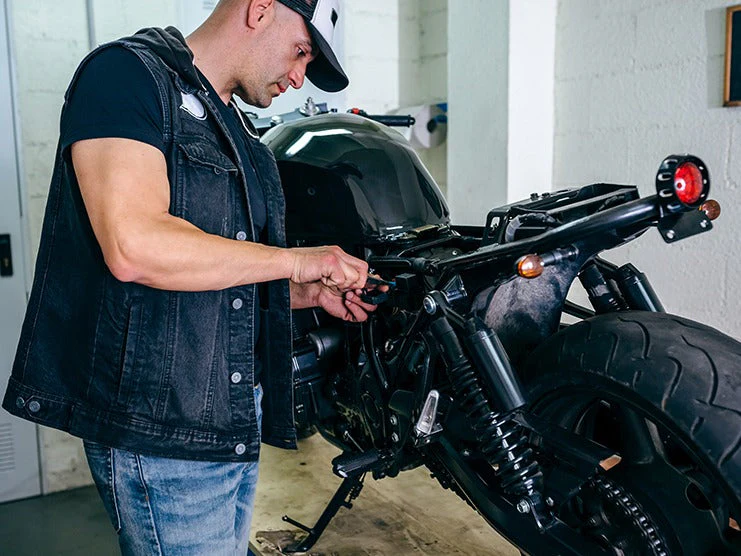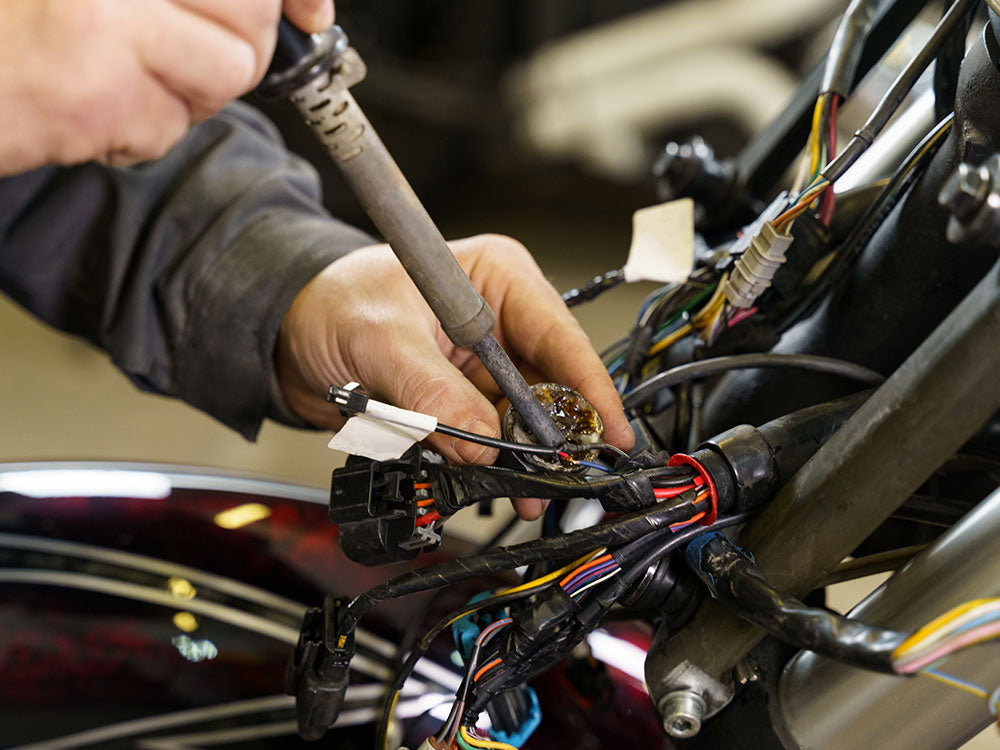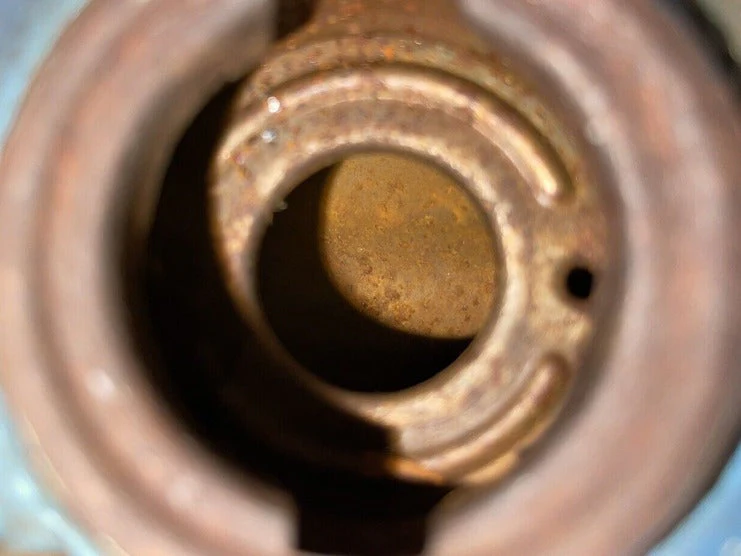A motorcycle fuse is a safety mechanism integrated into an electrical system that prevents melting and electrical damage. An average motorcycle has eight to nine fuses (5 Amp to 40 Amp), each with a specific current rating. Whenever an excess current passes through a fuse, it heats up and blows to protect the other components connected to that circuit.
This article discusses the reasons why motorcycle fuses blow, the signs of a blown fuse, and how to confirm if a fuse is blown.
Table of Content

1. Motorcycle Fuses

A motorcycle fuse is an electrical safety tool that protects parts from overcharging. Whenever an electrical current exceeds its limit, an electric circuit can become damaged. Fuses absorb the excess electricity and blow out to protect the electrical circuit.
A blown fuse must be replaced with a fresh fuse with a similar rating. Without a fuse, the entire circuit would be destroyed and would need to be fixed or replaced, with either option being expensive.
Different electric circuits of the bikes require fuses to safeguard them from overcurrent. The fuse will blow out once there is too much current flowing through to protect the circuit.
As there are many different circuits, there will be a lot of fuses, and each fuse will protect a different circuit.
That’s why fuse technology is crucial to the motorbike electric system. Electric equipment and devices would be damaged very often without fuses. They would also be expensive to fix.
2. What Should You Do if the Motorcycle Fuse Repeatedly Keeps Blowing?
If your motorcycle fuse keeps blowing repeatedly, it is probably because of the following:
- Fuse with incorrect ampere rating
- Issues with electric connection
If your motorcycle fuses keep blowing repeatedly, check the rating of the fuses. If the previous fuse had a rating of 10A, the new fuse must have the same rating.
If there isn’t any problem with the fuse, the issue may lie with the electric connection. Take your bike to a service shop to be inspected by a professional.
3. Reasons Why Motorcycle Fuses Keep Blowing
3.1 Excess Power from a Component
A motorcycle fuse often blows due to too much power being drawn from components connected to the electrical system. The components often responsible for blown fuses include the starter, the headlight, a poorly connected ignition coil, or an onboard computer that regulates fuel injection and timing.
A fuse will explode if a component connected to your bike's circuitry has a fault and draws more power than normal.
Modern motorcycles have several electronically controlled or electric-powered components. If any of these components are faulty, they may need more power to make up for the deficiency. If too much power is drawn, it may also cause electrical damage.
A fuse will explode if a component connect to your bike’s circuitry become overloaded. Any excess power in the circuit will be lost when the fuse blows.
For instance, if your starting drive gear jams, the starter will use more battery current.
If only a quick surge is required, the equipment might be able to power itself without the circuit becoming overloaded. However, if the gear remains stuck, it will draw more power. The circuit will eventually draw too much current, and its fuse will eventually blow before the wires melt or other parts of the same circuit fry.
Below are components that can draw too much power and cause a fuse to blow:
- Fuel Injection
- Fuel Pump
- Display Gauges
- Battery
- Ignition Switch
- Headlights
- Ignition Coil
- Starter Relay
3.2 Short Circuit
As a motorbike ages, the connections begin to rust and the wires become more brittle. The wires suffer wear and tear over many years of use. The plastic covering the wires becomes brittle and cracks as a result.
The end of a wire will often have a segment of copper wiring exposed after it breaks. The wire will provide a path for the current from the stator or battery to flow into the ground without much resistance as long as it does not come in contact with anything metal, such as the frame, engine, or fuel tank. Either the wire will burn or a fuse will blow as a result of this.
Another reason why a wire creates a short circuit is due to aftermarket lights or gauges being installed. To install these aftermarket parts, you would have to cut the cables, expose copper wiring, and tape the wires together. This is the worst way to connect wires and frequently results in blown fuses.
A broken wire can cause a short circuit in the ground, causing the circuit to become damaged. As soon as the fuse detects the short circuit, it blows to shut off the power supply to prevent further damage.
If the fuse blows because of a worn, corroded, or exposed wire, changing the fuse is only a temporary fix. The short circuit will keep grounding the electrical current and blowing any new fuses until the old or damaged wire is replaced.
3.3 Incompatible Fuse & Circuit
Modern motorcycles typically have multiple electrical circuits. While some models have multiple circuits connected to a single fuse, the majority of modern wiring harnesses connect each fuse to an individual circuit. Even if you replace the headlight fuse after a short circuit causes the fuse to blow, the starter circuit will still malfunction.
Check the service manual for your motorcycle's model, year, and manufacturer for the wiring harness diagram. The visual aid will show the number of circuits available and which ones share fuses.
3.4 Aftermarket Electronic Accessories Installed Incorrectly
If an aftermarket electronic part isn't installed correctly into your motorcycle's electrical wiring system, the fuse connected to the new part’s circuit may blow. Adding extra electronics may require more power than your battery can provide.
Also, electronic accessories may be installed incorrectly due to splicing them into the circuit, covering the exposed copper with electrical tape, and cutting the wires.
3.5 Wrong Fuse Rating
A motorcycle fuse often blows due to having a rating that is incompatible with the circuit.
Different fuses have different amperage ratings. Ratings on motorcycle fuses indicate how much power they can handle transferring to the circuit without blowing.
The standard motorcycle fuse ratings are:
- 5 Amps
- 10 Amps
- 15 Amps
- 20 Amps
- 30 Amps
Every electrical circuit on your motorcycle is connected to electronically driven parts that require power from the battery to operate.
Each of these parts has a maximum amount of power it can withstand before they burn out and requires a specific amount of power to operate.
For instance, the quantity of power required to run your starter and headlights is different. The fuse that is installed in each circuit is designed to blow before an overload of the component it is powering occurs.
A 15 Amp fuse in the circuit will blow as soon as 15 Amps of electricity flow through it. If the circuit requires 20 Amps, the fuse will blow before it reaches its typical power.
3.6 Overloading the Engine
A fuse often suffers damage due to overloading. If an electrical component becomes damaged, the fuse will be destroyed if it overloads. It is best to replace an electrical component if it shows signs of being faulty.
3.7 Riding at High-Speed
A fuse can become damaged if you ride it too fast. A fuse is more likely to suffer damage if you travel at high speeds over rough terrain. It is best that motorcyclists travel at a moderate speed when riding on rough terrain.
3.8 Moisture Buildup
If you park your motorcycle in a damp location, there’s a possibility that moisture will enter the wiring. This may result in several problems, including short circuits, broken wiring, and a blown fuse.
3.9 Faulty Starter Relay
If your motorcycle has a faulty starter, it will repeatedly cause the fuses to blow until it is repaired. A faulty starter relay will consume more energy than the circuit can handle when active.
Signs of a Faulty Starter Relay:
- Frequently requires multiple tries to start the motorbike.
- Motorcycle produces a clicking sound; this sound is made when the relay fails to supply electricity to the solenoid.
3.10 Battery Failure
The erratic behavior of your motorbike battery may result in fuses blowing in several circuits if it has a poor ground or expired.
How to Check for a Faulty Battery:
- Check the battery’s connections to see if they are loose since weak connections can result in starting issues.
- Inspect the battery's connections and terminal wires for signs of corrosion or damage. Failure of batteries is frequently caused by corrosion or shredding in the terminals.
- Look for any damages, rust, or lose connections in the ground cable.
- In order to confirm that a dead or defective battery is the real cause, test your battery using a multimeter as directed by the multimeter's instructions.
3.11 Faulty Ignition Switch
A worn or faulty ignition switch will draw more power into its circuit, which can result in the fuse blowing.
As the ignition switch is connected to the starter circuit, a malfunctioning ignition switch will frequently result in blown starter fuses.
Replace any frayed ignition switch wires immediately, especially if they are the cause of circuit shorts. To prevent the starter fuses from blowing, change out any worn or corroded ignition switches.
3.12 Require a Circuit Breaker
You might require a circuit breaker to protect your motorcycle’s circuit if the electrical wiring has been modified or installed with additional equipment.
Installing a circuit breaker is a valuable alternative if you have trouble using a wiring harness.
A circuit breaker functions the same as a fuse. If a fuse blows, the circuit breaker disconnects the electricity when it senses too much amperage to prevent the circuit from overloading.
The difference between a fuse and a circuit breaker is that the former has to be replaced after being blown while a circuit breaker does not.
When starting your bike, the circuit breaker will immediately switch off the ignition if it detects any electrical issues.
Much like fuses, different circuit breakers have different ratings. If you want to install a circuit breaker on your motorbike rather than a fuse, make sure you get one with the same rating as the previous circuit breaker.
4. Signs of a Blown Fuse
4.1 Headlights Are Not Working
The headlights won't turn on if the fuse, particularly for the headlights, is blown. If you confirm a blown fuse is the cause of faulty headlights, get a replacement immediately.
4.2 Motor is Not Operating
A motorbike will operate at a lower speed or often stop if the motor fuse is blown. Verify the engine's proper operation. Check the fuse if you believe there is an issue. Hence, the inability of the motor to function may be a sign of a blown fuse.
4.3 Battery is Not Charging
The battery won't charge if the battery fuse is broken. Other electronic accessories are likely to malfunction if the motorbike battery does not work. The battery will become unusable if it is not properly charged. Before going on a ride, try to determine whether the battery fuse is blown.
4.4 Decreased Speed
If the engine fuse is damaged or broken, it will cause your motorcycle’s speed to decrease. The motorcycle may even suddenly stop while riding. It is best to avoid riding your motorcycle if there are signs of a blown fuse.
4.5 Motorcycle is Completely Dead
If you try to turn on the ignition and nothing happens, there is a possibility that a fuse has blown at the ignition circuit. Consult your owner’s manual and check the fuse since it will look a bit different from the other fuses. If you find a blown fuse, replace it with a new one with the same rating.
5. How to Confirm if a Motorcycle Fuse is Blown
To check your motorcycle fuse, follow these simple steps:
5.1 Turn Off the Engine
Turning the engine off and wait for the engine to cool before starting the inspection.
5.2 Open the Fuse Cover
Remove the seat to expose the fuse cover. Then open the fuse cover so you can access the small fuse box.
5.3 Remove the Fuses
After opening the fuse box, remove the fuses one by one.
5.4 Check the Fuses
Check each fuse for damage; if the U-shape is broken, the fuse has been blown. Inspect all the fuses and replace any that are damaged.
6. Last Words
Motorcycle fuses detect excess power traveling into the circuit, absorb the extra electricity, and blow up to protect other components. Sometimes a motorcycle keeps blowing a fuse again and again due to various issues, such as too much power, the wrong fuse rating, the fuse and circuit being incompatible, the engine overloading, moisture buildup, a faulty ignition switch, battery failure, and a faulty starter relay. If you wish to improve your motorcycle’s overall appearance, you can add new Saddlebags, sissy bar bags, touring packs, handlebars, fairings, seats, crash bars, luggage racks, and sissy bars.













Leave a comment
All comments are moderated before being published.
This site is protected by hCaptcha and the hCaptcha Privacy Policy and Terms of Service apply.